Decoding Gmail Analytics: Measure Your Email Performance

Table of contents
Email is primary communication channel for businesses. And so, understanding email performance is vital for any business as it directly impacts customer engagement, brand perception, and ultimately, business growth.
Businesses that harness insights from their email analytics have a distinct advantage. They foster stronger relationships and drive more meaningful engagements with their audience.
And if you use Gmail for your business communication, you should invest in a Gmail analytics tool.
Gmail analytics offers businesses a clear picture of how their emails are performing. Whether you’re a small business trying to connect with your customers or a large corporation aiming to streamline internal communications, Gmail analytics provides invaluable insights.
By decoding these insights, businesses can refine their strategies, ensuring every email sent is effective and resonates with its intended target audience.
In this article, we’ll dive deep into the world of Gmail Analytics, exploring its uses and the top Gmail analytics tools to try out. We will also explain the key metrics that can be important for your business and how to track them.
Table of Contents
- What is Gmail Analytics?
- Top Gmail Analytics Tools to try out in 2025
- How To Set Up A Gmail Analytics Tool: A Step-by-Step Guide
- Key Metrics to Track With Your Gmail Analytics Tool
- Common Challenges and Solutions in Your Gmail Analytics Tool
- Analyze Your Email Metrics With Hiver
- Frequently Asked Questions (FAQs)
What is Gmail Analytics?
Gmail Analytics is a tool that provides insights into the performance of your email communications within the Gmail platform. In a business set up, it allows marketers, sales teams and even your customer support teams to analyze email performance through important metrics , such as open rates, click-through rates, response times, and more.
With Gmail analytics, individuals and businesses can gain a deeper understanding of their email interactions. Here’s what you can do with Gmail Analytics:
- Measure the health of your email marketing campaigns: Track the success of your email marketing efforts by analyzing open rates, click-through rates, and conversions.
- Optimize email content: Identify which email content resonates best with your audience and tailor future campaigns accordingly.
- Improve customer engagement: Gauge customer interest and satisfaction through email interactions.
- Analyze sales funnels: Track email performance at different stages of the sales process to identify areas for improvement.
- Measure team productivity: Monitor email activity and response times within your team to assess productivity and identify bottlenecks.
Top Gmail Analytics Tools to try out in 2025
In this section, we’ll explore some of the powerful Gmail Analytics tools to try out. We’ll discuss the features and pricing of these tools, so that you can make the best choice for your business.
| Tool | Features | Startingprice |
|---|---|---|
| Hiver | – Seamless Gmail Integration – Team Performance Metrics – Response Time Analysis – Email Volume Tracking – Shared Inbox – AI functionalities | $19/user/month. Has a free plan as well. |
| Email Analytics | – Email Traffic Analysis – Comprehensive Email Metrics – Top Senders & Recipients Identification | $14/user/month |
| Gmelius | -Helpdesk Integration -Advanced Tracking & Reporting -Email Templates | $10/user/month |
| Right Inbox | – Email Tracking – Reminders – CRM Integration | $7.95 per month/user |
| DragApp | – Kanban Boards for Email organization – Shared Inboxes – Basic Email Tracking features | $8/user/month |
| MailTracker by Hunter | – Real-time Email Open Alerts – A/B Testing Functionality – Spam Alerts – Unopened Email Reminders | $20/user/month |
1. Hiver
Hiver is a robust Gmail based helpdesk system, known for its ability to assist companies in efficiently handling interactions with customers and employees.
Since it works on top of Gmail, teams can work together on emails and conduct Gmail analysis without having to learn a new software. You can get started with Hiver in the matter of minutes, by simply adding its as a browser extension. And the best part is, Hiver offers a forever free plan that can help you transform your inbox into an intuitive help desk.

Key features
- Seamless integration with Gmail: Because Hiver works within Gmail, it can effortlessly capture all email communication. This enhances the accuracy of the email analytics in Gmail.
- Performance metrics for teams: Hiver enables managers and team leaders to monitor individual performance metrics. With its robust analysis you can recognise high performing individuals who can efficiently resolve customer queries and also identify those needing additional training.
- Response time analysis: You can monitor the average time taken by your teammates to respond to emails. This measurement is vital for customer service and sales teams to ensure timely interaction with customers and leads.
- Email volume tracking: Analytics also show quantity of incoming and outgoing emails, aiding teams in distributing incoming workload efficiently.
- Custom dashboards: Admins can create their own reporting dashboards to view all crucial performance indicators across different inboxes.
- AI capabilities:Hiver’s AI summarizer compresses longer emails into concise summaries for agents to resolve conversations faster. AI also generates intelligent email template suggestions to speed up response time.
Pricing:
- Free plan: Free forever
- Lite plan: priced at $19/month/user, billed annually.
- Pro plan: priced at $49/month/user, billed annually.
- Elite plan: priced at $79/month/user, billed annually.
2. Email Analytics
Email Analytics is an effective Gmail analytics tool that measures and improves email response time. It has some really useful features that provides businesses with valuable insights of their daily email interactions.
It seamlessly integrates with your Gmail inbox, eliminating the need of downloading or learning a new software.
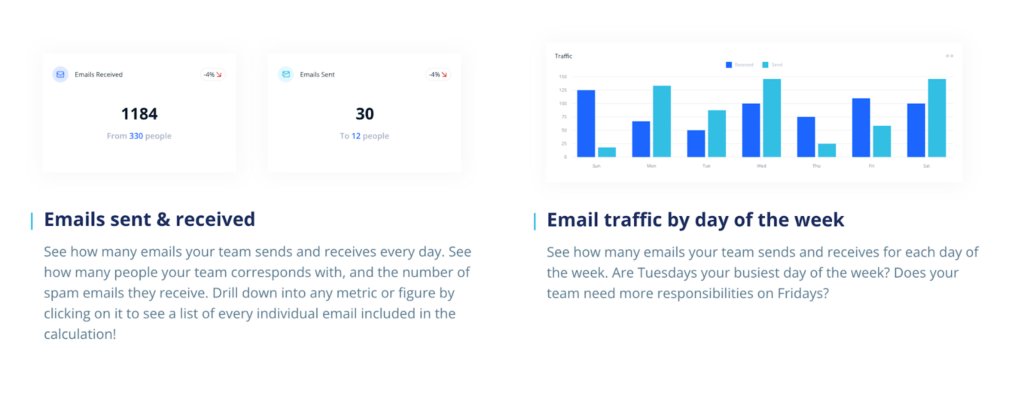
Key features:
- Email Traffic Analysis:Gain insight into the number of emails sent and received by your team on various days of the week. This can help identify the peak email activity days and potentially underutilized days.
- Comprehensive set of email metrics: View the quantity of emails your team sends and receives each hour and every day, the customers/leads they communicate with, and even the volume of spam they get.
- Top Senders & Recipients: Identify who communicates most frequently with your team. Get an insight on which customers or connections are the most involved and examine the average time it takes to respond to each recipient.
Pricing:
- Pro: $14/user/month, billed annually
- B2B email outreach: $900/user/month, billed annually
3. Gmelius
Gmelius is a Gmail based tool that transforms Gmail into a collaborative workspace.It offers a comprehensive suite of features that enhance team collaboration, improve employee productivity, and provide valuable insights into email performance.
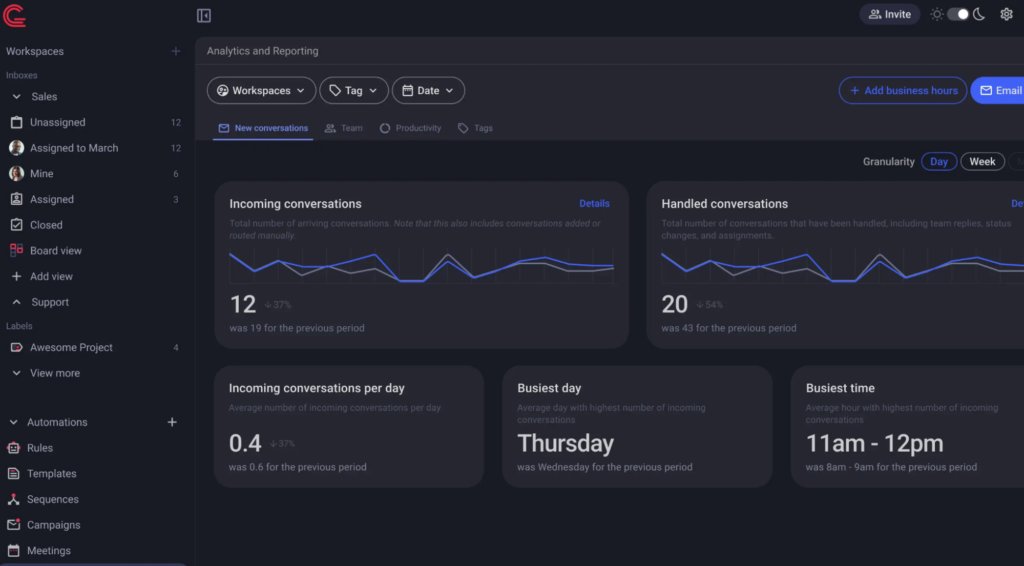
Key features:
- Helpdesk integration: Gmelius enables teams to make customer interactions more efficient by converting Gmail into a collaborative helpdesk system.
- Advanced tracking and reporting: provides thorough analytics on email performance, such as open rates, click-through rates, response times, and additional metrics. You also have the option to generate personalized reports according to the goals of your team.
- Email templates:With Gmelius, users can conveniently create and store email templates for sending consistent and professional emails within a few clicks.
Pricing:
- Lite: $10/user/month, billed annually
- Growth: $24/user/month, billed annually
- Pro: $36/user/month, billed annually
Recommended read:Top 10 Gmelius Alternatives for 2025
4. Right Inbox
Right Inbox is a popular Gmail- based productivity tool that offers some really powerful analytics features alongside its other functionalities like email automation and scheduling. It is a versatile tool to manage business emails.
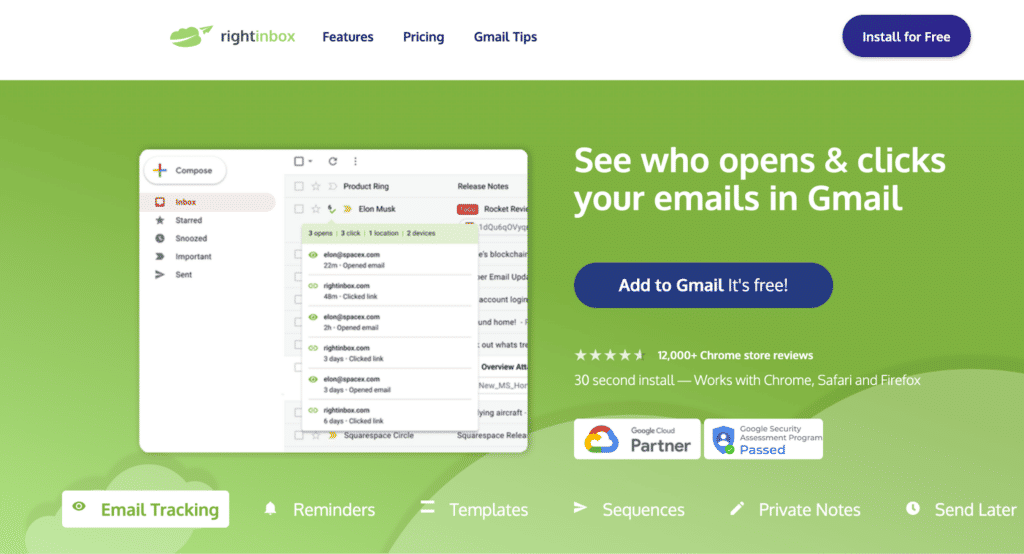
Key features:
- Email Tracking: Monitor when, how many times, and by whom your emails are opened, as well as track link clicks within the email.
- Reminders: You can set automatic follow-up reminders to ensure you never miss out on important email conversations.
- CRM Integration: Integrate Right Inbox with popular CRM tools to streamline your sales and customer relationship management processes.
Pricing
- Free Plan: This allows email tracking for up to 5 emails per month
- Personal Plan: Priced at $7.95 per month, billed annually. This plan allows unlimited email tracking.
- Professional Plan: Priced at $14.95 per month, billed annually. This plan offers advanced email analysis features along with email tracking.
5. DragApp
Drag is not just an email productivity tool; it is a versatile platform that enables teams to work together within the Gmail interface, organize tasks, and streamline their workflow. While it doesn’t boast of the granular analytics offered by otheremail tracking tools, DragApp offers a fair idea on your team performance and email engagement.
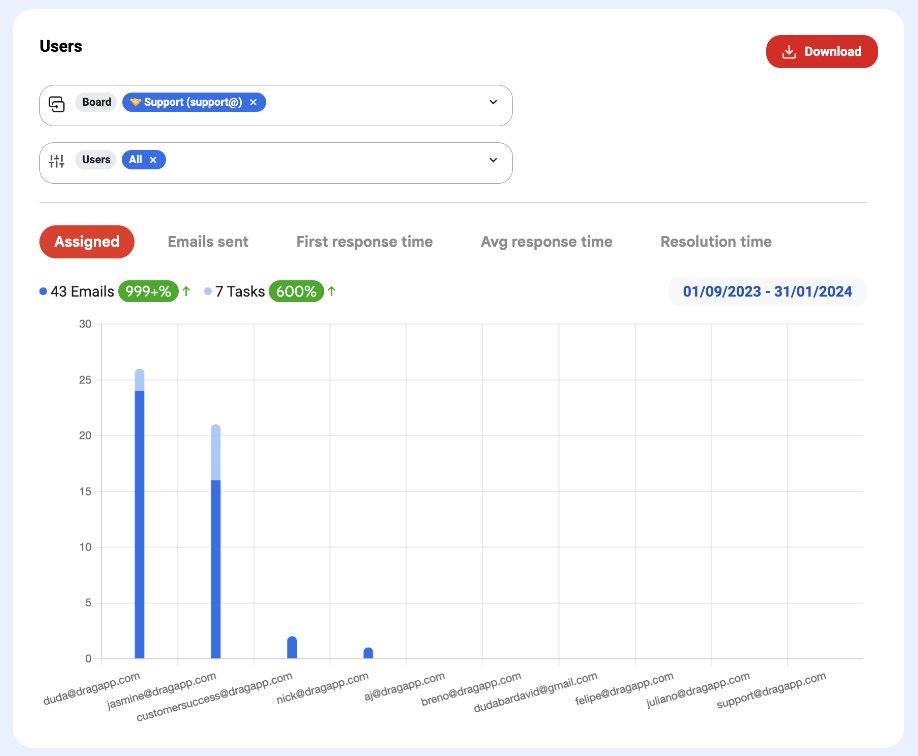
Key features:
- Kanban Boards: Drag introduces the concept of Kanban boards to Gmail, enabling users to visualize their emails and tasks in a structured manner.
- Shared Inboxes: Teams can manage shared emails like support@ or sales@ directly from Gmail, streamlining communication and ensuring timely responses.
- Email Tracking: Monitor when your emails are opened, providing insights into recipient engagement.
Pricing:
- Starter Plan: Priced at $8/user/month, billed yearly
- Plus Plan: Priced at $12/user/month, billed yearly
- Pro Plan: Priced at $16/user/month, billed yearly
Recommended Read: Gmelius vs DragApp: What to Choose in2025 (Comparison)
6. MailTracker by Hunter
Mailtracker by Hunter is a specialized email tracking platform designed for Gmail users. It offers real-time insights into email interactions, empowering users to make timely follow-ups and optimize their email strategies.
Integrated seamlessly with Gmail, Mailtracker ensures that users have a clear understanding of their email performance.
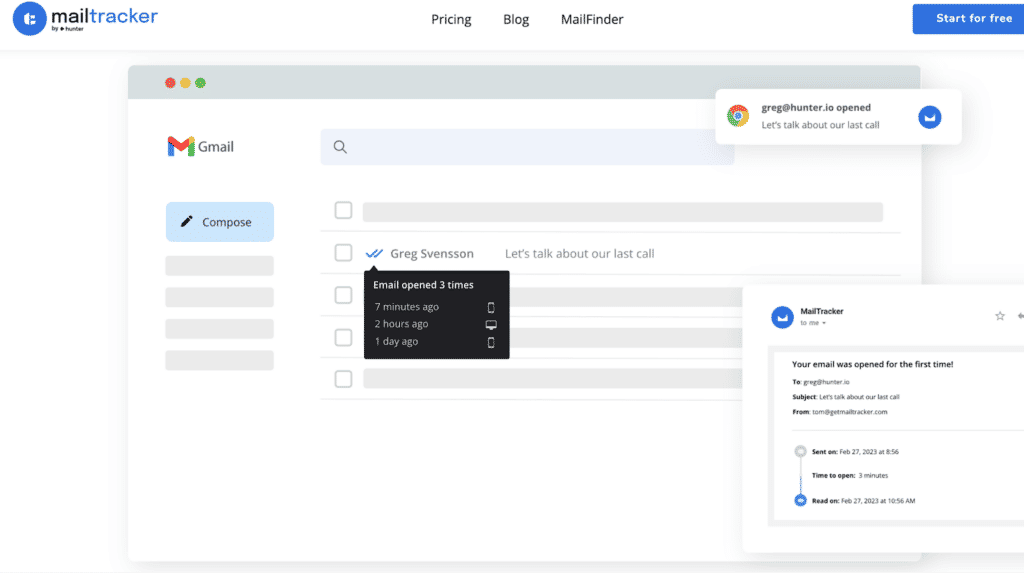
Key features:
- Real-time alerts: Receive instant notifications when your email is opened, ensuring you’re always in the loop about your email interactions.
- A/B testing functionality: Test different email elements to identify what resonates best with your audience, optimizing your campaigns for better results.
- Spam alerts: Monitor if your emails are being opened correctly and ensure they aren’t landing in spam folders.
- Open rates: Understand which email subjects resonate with recipients, potentially increasing your open rate by up to 20%.
- Reminders for unopened emails: Receive reminders if an email hasn’t been opened within 48 hours of being sent out.
Pricing:
- Growth plan: Priced at $20/user/month, billed annually
- Enterprize Plan: custom pricing
How To Set Up A Gmail Analytics Tool: A Step-by-Step Guide
The success of your business can depend on how effective your email communication is. Whether you are contacting potential clients, maintaining current relationships, or responding to customer inquiries – your communication methods are a way to win your customers or prospects’ faith. And how do you understand if your emails are working? By analyzing trends.
So, if you use Gmail for your email communication, here’s a guide on how to set up a Gmail analytics tool to analyze your emails.
1. Choose the right tool
Even though Gmail has some tracking capabilities, to fully utilize Gmail Analytics, you may need to integrate or install some external tools designed specifically for this purpose.
You can choose any of the tools mentioned in the above section, depending on your business needs. These tools provide a wide range of advanced reporting capabilities, and can also help you create your personalized reporting dashboards.
2. Ensure the tool integrates with Gmail
Start by connecting your preferred analytics tool to your Gmail account. This often includes a simple process. You might need to find your preferred tool in Google Workspace marketplace and add a plugin to sync your Gmail account with the tool.
For businesses with multiple departments or teams using Gmail, ensure that the tool supports multi-user access, to support and view email data from the whole organization.
Recommended read: 12 Best Gmail Add-Ons to Boost Your Productivity
3. Define and prioritize metrics
Every business has its own distinctive objectives. You might want to keep a close eye on your email open rates, or click-through rates. Your aim can also be to reduce response times. List down all the metrics that align with your business goals to keep your analysis on track and purpose-driven.
We will also cover a list of important metrics later in this blog.
4. Implement tracking mechanisms
Include tracking pixels or unique URLs in your emails. Based on your tool, it is through these unique codes, that your Gmail Analytics tool would be able to track engagements such as open rate, click rate, and forwards.
For instance, if you send a newsletter featuring a new product feature, adding a UTM code can show you how many recipients opened and interacted with the email.
5. Customize the analytics dashboard
Customize your Gmail Analytics tool’s dashboard to keep all your important metrics easily indentifiable. Having a well-structured dashboard allows businesses to extract insights, leading to quicker data-driven decision-making.
Recommended read: How to Use Customer Service Data For Strategy Creation and Growth
6. Conduct preliminary tests
Testing your Gmail Analytics tool is essential before implementing it. Send accross test emails to a selected group/team and observe if the analytics tool correctly records the information. This guarantees that when you expand on a larger level, the data you collect is accurate and trustworthy.
7. Regularly monitor and analyze
Once you set up your Gmail analytics tool, be sure to regularly check your metrics. By staying vigilant about your email performance, you can anticipate and resolve problems quickly.
For instance, if you have questions like: is the subject line compelling enough? Or are the emails landing in the spam folder? You can go through the metrics and find out these answers. This way you can refine their strategies and ensure optimal outcomes in subsequent campaigns.
8. Stay updated
The world of Gmail Analytics, like all digital domains, is ever-evolving. Regularly update yourself on the latest features, metrics, and best practices. This ensures that your business remains at the forefront, and leverages your chosen tool to its fullest potential.
Key Metrics to Track With Your Gmail Analytics Tool
Your chosen Gmail Analytics Tool can provide numerous metrics that offer valuable insights into email performance. Let’s explore some of these important metrics and what they tell you about your email performance.
1. Open rates
The open rate metric is essentially the percentage of recipients who have opened an email out of all the emails sent. It shows exactly how your email is received in a recipient’s inbox at first glance.
Businesses frequently analyze the success of an email marketing campaign by first examining its open rates.
A variety of factors could contribute to the low open rate. For instance:
- Subject Line: This is potentially the most crucial factor. If the email’s subject line is not captivating or relevant to the recipient, they may choose to ignore the entire email and not open it.
- Sender Reputation: If past emails from the sender have been identified as spam or not engaging, recipients may disregard future emails.
- Timing: The timing of sending an email can impact how many people open it. Email open rates can increase by sending emails recipients are most engaged.
- Email Preview: The brief text seen prior in the inbox dashboard, opening an email, could impact the recipient’s choice to either open or ignore it.
2. Click-Through Rates (CTR)
The Click-Through Rate (CTR) is the percentage of users who click on a certain link in the email out of the total number of users who saw the email. It directly shows how successful the email is at encouraging recipients to take action.
Click-through rate (CTR) is an important indicator that evaluates your customers’ active participation. There are various factors that impact CTR:
- Relevance of Content: If the content is relevant to the recipient’s needs or interests, they are more likely to click on embedded links.
- Quality of Call-to-Action (CTA): This plays a crucial role in improving (CTR). The call-to-action, whether it says “Learn More,” “Shop Now,” or “Get Started,” must be clear and enticing.
- Email Design: A visually appealing email featuring strategically placed links can boost click-through rates. CTR might be negatively impacted if the links are hidden within a block or the mail has a complex design that’s not intuitive.
- Credibility: Emails that are perceived as authentic and trustworthy are more likely to have increased click-through rates. Recipients may be wary of clicking on links in emails that appear to be suspicious or spam.
3. Bounce rates
Bounce rate is the percentage of emails that do not make it to the recipient’s inbox successfully. There are two main types of bounces:
- Soft Bounces: These happen due to temporary problems with email delivery, like a full mailbox or server outage.
- Hard Bounces: They occur when there is a permanent failure in delivering an email. They are typically caused by invalid email addresses or a domain that blocks the incoming mail.
Bounce rates are critical email marketing metrics for several reasons:
- Email List Health: A high bounce rate signify outdated or inaccurate email addresses within the list. Regularly cleaning and updating the email list can reduce hard bounces.
- Sender Reputation: Email service providers monitor bounce rates, and a consistently high bounce rate can harm the sender’s reputation. This can lead to emails being more frequently flagged as spam or even blocked.
- Lost Opportunities: Every bounced email represents a missed opportunity to connect with a potential customer or engage an existing one.
- Cost Implications: Many email marketing platforms charge based on the number of emails sent. Bounced emails represent a cost without any potential return on investment.
4. First Contact Resolution (FCR)
First Contact Resolution (FCR),is the rate at which your customer support team resolves customer queries within the first point of contact with your customers. This is a metric that gauges the efficiency of your customer support team.
A high FCR rate can help in many ways:
- Customer Satisfaction: When issues are resolved quickly without the need of back-and-forth communication, your customers are likely to be more satisfied with your service.. Clients value quick and efficient resolutions, resulting in more confidence in the brand.
- Operational Efficiency: A high resolution rate indicates that the support team is well-trained has the all necessary resources to handle common issues.
- Brand Reputation: In the age of social media and online reviews, a brand’s reputation can be significantly influenced by its customer support efficiency. A good resolution rate has the potential to generate good reviews and recommendations from customers, enhancing the brand’s reputation.
5. First Response Time
First Response Time (FRT) captures the duration between a customer’s initial email query and the moment the support team sends their first response. FRT measures the proactiveness and responsiveness of your support team.
Measuring FRT of your support team is important for many reasons:
- Setting Expectations: The first response often sets the tone for the entire support interaction. A swift initial response can reassure customers that their concern is acknowledged and being addressed, even if a complete solution might take longer.
- Brand Perception: In today’s digital age, where customers expect quick solutions, the speed of the first response can significantly influence a brand’s perception. Brands that are seen as responsive and attentive are more likely to earn customer trust and loyalty.
- Competitive Advantage: In industries where multiple companies offer similar products or services, a faster FRT can be a differentiating factor, giving one brand an edge over competitors.
- Operational Insights: Monitoring FRT can provide insights into operational efficiency. For instance, longer FRTs during specific hours might indicate the need to hire more support agents during peak times.
6. Escalation rate
The Escalation rate measures the number of times a customer’s problem, which is first addressed by frontline or first-tier support, needs an interventiont from the higher ups or management. This may happen because the problem is complex, requires specific expertise, or when regular solutions do not solve the customer’s issue.
The effects of a high Escalation rate could mean a number of this:
- Operational effficiency: Every escalation means that more time and resources spent on a single issue. Frequent escalations can increase the work load of the higher-ups or management, diverting them from other critical tasks.
- Customer experience: Although some escalations are unavoidable, but frequent escalations can result to longer resolution times. This could test a customer’s patience and possibly result in dissatisfaction. An efficient support process typically includes addressing problems at the lowest level as soon as possible.
- Training and knowledge Gaps: High escalation rate may indicate deficiencies in training or resources among frontline support. It can indicate specific topics or issues that require more in-depth training sessions.
You may also like: 18 Key Customer Service Metrics + How to Use Them
Common Challenges and Solutions in Your Gmail Analytics Tool
Gmail Analytics has become an indispensable tool for businesses that aim to optimize their email strategies. However, like any technology, users might encounter challenges while using these tools.
Here’ are some of the common issues and their solutions:
1. Data overload
Challenge: With so many metrics to keep track of, businesses can sometimes feel overwhelmed. They can struggle to find out which data points are truly relevant and which aren’t.
Solution: Start by defining clear objectives for your email campaigns. Once you know what you aim to achieve, focus on those specific metrics that align with those goals. For instance, if your goal is to enhance customer engagement, metrics like open rates and click-through rates are important to track.
2. Inaccurate data interpretation
Challenge: Misinterpreting data can lead to misguided strategies. For example, a high email open rate might seem positive, but if these email campaigns also show high unsubscribe rate, there’s an underlying issue.
Solution: Always analyze metrics in conjunction. Look for patterns and correlations between different data points to get a holistic understanding of your email performance.
3. Privacy concerns
Challenge: With increasing emphasis on data privacy, some email recipients might use tools that block tracking pixels, leading to inaccurate tracking data.
Solution: While it’s challenging to bypass such tools, businesses can focus on delivering value-packed content, ensuring even if tracking is blocked, the email serves its purpose. Additionally, always ensure compliance with email authentication protocols and data protection regulations.
4. Inconsistent data across tools
Challenge: If a business uses multiple analytics tools, there might be inconsistencies in the data reported.
Solution: Stick to one primary tool for Gmail analytics to ensure consistency. If multiple tools are necessary, regularly cross-check and calibrate them to ensure they’re aligned.
5. Not tracking the right metrics
Challenge: Businesses might focus on vanity metrics that don’t necessarily align with their objectives. For instance, tracking only open rates without considering conversion rates can lead to misinformation on your email performance.
Solution: Regularly review and refine your analytics strategy. Ensure that the metrics you’re tracking directly correlate with your business goals. For example, if lead generation is the aim, focus on metrics like click-through rates to specific product pages or sign-up forms.
Analyze Your Email Metrics With Hiver
Gmail Analytics has undeniably transformed the way businesses approach email communication. It offers insights that drive informed and effective strategies. As we look to the future, we can anticipate even more advanced features, from predictive analytics with the help of AI to deeper integration with other business tools.
If you are looking for a Gmail Analytics tool that can help you streamline your customer communication, you should try Hiver.
Hiver not only helps you understand email performance with its robust reporting features, but also enhances team collaboration within Gmail. This makes it a dual asset for businesses aiming for efficiency and data-driven decision-making.
Frequently Asked Questions (FAQs)
- Why should I use Gmail analytics?
Because email is the most used channel for communication in businesses! By understanding how your emails are doing, you can make them better for your next campaign. You can write more engaging subject lines, craft content people actually want to read, and ultimately get better results from your email marketing efforts. You can also make improvements in your customer service operations based on these metrics.
- How do I set up a Gmail Analytics tool?
Easy! Most of them connect to your Gmail account through a plungin. Once you add the plug in, you’re all set. You can then customize your dashboard to see the metrics that matter most to you. The blog post has a step-by-step guide to help you out.
- How often should I check my Gmail Analytics data?
It depends on your specific needs and goals. However, it’s generally recommended to check your analytics data at least weekly to monitor trends and identify any issues.
- Can I use Gmail Analytics to track email performance for multiple Gmail accounts?
Yes, most Gmail Analytics tools allow you to track multiple accounts. This is especially useful for businesses with multiple teams or departments using Gmail.
- How can I integrate Gmail Analytics with other marketing tools?
Many Gmail Analytics tools integrate with other marketing platforms like CRM systems, marketing automation tools, and social media platforms. This can provide a more comprehensive view of your marketing efforts.

































